2016 MXA RACE TEST: EVERYTHING YOU NEED TO KNOW ABOUT THE 2016 HUSQVARNA FC450
Q: FIRST AND FOREMOST, IS THE 2016 HUSQVARNA FC450 BETTER THAN THE 2015 FC450?
A: Yes. Leaps and bounds better. No contest.
Q: HOW DOES THE 2016 HUSQVARNA FC450 DIFFER FROM THE 2016 KTM 450SXF?
A: There are 10 distinct differences between a Husky FC450 and a KTM 450SXF. Please memorize them, because there will be a pop quiz later.
(1) Price. The Husqvarna retails for $100 more than the KTM ($9399 versus $9299). This price variation can only be explained by the smaller production run of Husqvarnas (16,000 units) versus the economy of scale of KTM’s massive production run (150,000 units). It should be noted that at the dealership level, the price difference may well evaporate during the negotiating phase.
(2) Weight. The Husky FC450 weighs more than the comparable KTM 450SXF. The Husky’s extra baggage (229 pounds versus 227 pounds) is a function of the plastic subframe, brake rotors, swingarm and muffler more than anything else.
(3) Subframe. Husqvarna claims that its three-piece, carbon fiber-infused plastic subframe is 2.2 pounds lighter than last year’s subframe. On paper, this sounds very good, but don’t get too misty over either the weight savings or the words “carbon fiber.” The weight savings come from the simple fact that the 2016 subframe is much smaller and shorter than last year’s version, thus it weighs less because there is less of it. As for the carbon fiber aspect of the subframe, it is technically true, but this is a far cry from a carbon fiber subframe. In actuality, carbon particles are mixed into the plastic formula. Since the carbon is lighter than the oil-based plastic, there is a weight savings. How much carbon fiber is mixed in? The 2016 Husqvarna subframe is 30 percent carbon and 70 percent plastic.
(4) Swingarm. Although Husqvarna’s engineers never mentioned a swingarm change in their tech information, it is obvious that the swingarm is different from KTMs.
(5) Muffler. Back in 2013, KTM 350SXFs and 450SXFs had mufflers with ice cream cone-shaped restrictors inside them. Made out of rolled perf core, the cones cut down on the sound and throttle response. In 2014, KTM dropped the ice cream cone muffler inserts in favor of straight-thru perf cores with light-gauge wire screens. Guess what, the ice cream cones are back. Not on KTMs, but on the Husqvarna FC450. We don’t like this design (and obviously KTM didn’t either), but for sound reasons it is on the 2016 Huskys.
(6) Tires/rims/brakes. Husqvarna spec’ed MX52 tires. These are decent all-around tires and popular as OEM equipment because they are passable in a wide variety of terrain. KTM spec’ed the much more race-specific Dunlop MX32 intermediate. For racing on prepped tracks, the MX52 can’t touch the MX32. Husqvarna specs D.I.D. DirtStar rims, while KTM uses Takasago Excel rims. Additionally, KTM uses very lightweight Galfer rotors, while Husqvarna uses GFK brake rotors. The GFK discs have a different vent pattern and the rear rotor is thicker (24.5mm to 24.0mm).
(7) Clutch. The most noticeable change for 2016 is the use of a Magura clutch lever and master cylinder (instead of KTM’s Brembo components). There might be some purchasing benefit to Husqvarna for making this change, but for the consumer the big plus is that the Magura system operates on much more readily available brake fluid instead of the mineral oil Magura used to demand.
(8) Handlebars. The 2016 Husky FC450 is outfitted with Pro Taper bars in a proprietary Husqvarna bend. KTM uses Neken bars.
(9) Seat cover. Last year’s ice-skating-rink seat cover has been replaced by a monochromatic gripper cover that is more aggressive than KTM’s rough-surface cover.
(10) Look. None of the plastic pieces are shared with KTM. The truncated rear fender and platypus-bill front fender are acquired tastes, but the Navy blue/white/yellow plastic is all-new, along with color-coded ignition, clutch and valve covers.
Q: WHAT’S UNIQUE TO THE 2016 HUSQVARNA FC450?
A: The most visible innovation is the plastic subframe — a heritage part carried over from Husaberg. Look closely at the plastic bodywork. See any bolts holding it on? There aren’t any. The one-piece airbox cover/rear number plate plugs into nylon grommets. No tools required. Plus, the seat is held on by one bolt. There is nothing unusual about this. Husky used one bolt for years with a Dzus fastener through the top of the seat, and KTM did it up until last year with a single bolt from under the rear fender, but the 2016 Husky uses one bolt on one side of the frame (accessed through the airbox). The 2016 FC450 also has the handholds moved rearward by 1 inch to allow more leverage for lifting the bike up. Thankfully, Husky also reinforced the rear fender so that it doesn’t rip off if someone tries to grab it to pick up the FC450.
Q: HOW FAST IS THE 2016 HUSQVARNA FC450?
A: In the hierarchy of 450cc power mongers, the 2016 Husqvarna isn’t in the scary-fast category. Now you would think that since there is not one iota of difference between the internal parts of the class-leading KTM 450SXF engine and the FC450 engine that it would be a dead heat on a merry go-round. Not so. Why? While the internals may be identical, the externals aren’t. The Austrian engineers made some very deliberate choices regarding the style of power it wanted. The Husky could easily have had the same amount of power as the 2016 KTM 450SXF — which Honda, Kawasaki, Suzuki and Yamaha would jump at — but the engineers at Husky have a sibling rivalry with KTM’s engineers that doesn’t allow them, psychologically or perhaps corporately, to do what KTM does. We’re not sure that we like their decision, but we have to respect the bravery of a company that purposely detunes the power delivery of its product. However, maybe it’s just us, but we are suspicious that KTM doesn’t want the Husky to be as powerful as their bike — and since they call the shots — some of the detuning might be on purpose. No big deal because we can tell you how to get the power back.
Oh, don’t get us wrong, the 2016 Husky FC450 isn’t slow by any means; it’s just not rompin’, stompin’, white-knuckle fast. It is, for lack of a better phrase, “rheostat fast.” It has a steady, deliberate and metered pull that is superbly manageable. The breadth of the powerband is amazing in its length. The pleasant low-to-mid transition becomes stronger as you go—and it goes and goes and goes. What it doesn’t do is thrill you. It doesn’t have the gun-and-run surge that the KTM 450SXF and Yamaha YZ450F have. You catch and pass people by laying down smooth, effortless and consistent laps — not with bare-knuckle brawling out of the corners.
Once the MXA test crew realized that Huskys had a lap-time engine as opposed to a sprint engine, they calmed down and went to work with what it had to offer. Test riders could push the chassis of the FC450 to the limits of adhesion without fear of being bucked off by a sudden burp of testosterone from the powerplant. There was power everywhere, and while we might have wanted more power at different points on the space/time continuum, you gotta love an engine that churns from off-idle all the way to the top end. The 2016 Husqvarna FC450 powerband is long, broad and pulls forever. And, just to be perfectly clear, the Husky makes more peak horsepower than the 2016 Honda, Suzuki, Kawasaki or Yamaha.
Q: WHY IS THE HUSKY’S POWERBAND MELLOWER THAN THE KTM’S?
A: We need to address the elephant in the room. What did Husqvarna do to make the engine manageable instead of magnificent?
(1) They resuscitated KTM’s long-gone 2013 ice cream cone muffler core. By putting a restrictive cone in the end of the exhaust pipe, Husqvarna killed two birds with one stone: the restrictive muffler killed decibels to make it quieter than the KTM, while also killing throttle response. Whereas the KTM can bark with the slightest flick of the wrist, the Husky purrs. Are you a cat lover? If so, this muffler is for you. We took the stock straight-through muffler from our KTM 450SXF and put it on the FC450 and got the bark back. It is a simple fix, but it will cost you post-showroom money.
(2) Husqvarna’s engineers must have gotten their degrees in submarine design. They don’t want water to get in or air to get out. Whether it is submarine or enduro tech, Husqvarna seals off its airbox tighter than Jimmy Hoffa’s 55-gallon drum. And this is the third straight year of choking the FC450 off. It took us a while to trace the path that air has to take to get into the FC450 airbox. Hidden inside the hand holds on the side panels are slots that direct air under the seat, where it goes through openings in the plastic subframe and eventually gets to the air filter. Both the muffler and the air inlets suffer from chronic obstructive pulmonary disease. The FC450 can’t take a deep breath, nor can it exhale fully. Break out the drill and open up the right side of the airbox (behind the sidepanel) to let the breath of life in.
Q: HOW DOES THE 2016 HUSQVARNA FC450 RUN ON THE DYNO?
A: The 2016 Husqvarna FC450 makes 57.14 horsepower at peak (9300 rpm). That makes it the second most powerful 450 of 2016—behind the 57.98 horsepower KTM 450SXF, but ahead of the YZ450F’s 56.85 horsepower, KX450F’s 55.40 horsepower, RM-Z450’s 54.88 horsepower and CRF450F’s 53.03 horsepower. The real question is how much power do the ice-cream-cone muffler and convoluted air-intake system cost the FC450 versus the 450SXF. The answer is 1.0 to 1.25 horsepower at 5000, 6000, 7000, 8000, 9000, 10,000 and 11,000 rpm. It’s one thing to give up 1 horsepower at peak; it is a completely different thing to give up 1 horsepower at every step on the curve from bottom to top.
It is worth mentioning that while dynoing the FC450, we propped the airbox cover open and gained a measurable amount of horsepower at every step along the curve. More significant is the increase in throttle response.
Q: HOW GOOD ARE THE 2016 HUSKY’S 4CS FORKS?
A: Unlike in the past, most MXA test riders are willing to race with the production WP forks this year. What changed? WP’s mindset. Prior to the 2016 version of the 4CS fork, WP was chasing a setup for a rider who wanted incredibly harsh forks that loosened teeth and sent the front end chattering across rough ground; however, WP was never able to tap into that mythical market. So, for 2016, WP decided to build forks for the actual people who buy and race its bikes. And that isn’t AMA Pros or 17-year-old home-schooled Loretta Lynn wanna-bes. Surprise! Even though they said it couldn’t be done, the forks on the 2016 Husqvarna FC450 are plusher and more resilient than anything WP has offered over the last decade. The test rider consensus was that these forks were raceable in stock trim. They want to move. They feel fluid. The clickers actually make a difference (before, you could only choose between harsh and harsher).
But not everyone will be happy with the stock WP setup. Fast Pros, jump tracks and teenage Intermediates will not like Husqvarna’s decision to go with comfort over stiffness. These forks can and will bottom in the hands of a Pro rider — but we don’t know any Pros who race with stock suspension (and that goes for Pros with Yamaha SSS forks).
Q: WHAT ABOUT THE REAR SHOCK?
A: We are not fans of the 48 N/m shock spring on the FC350 or FC450. It only works well for riders around 190 pounds. Anyone lighter than that will have problems getting any preload on the shock spring. The saving grace for the FC450 is that most 450cc riders are larger and heavier than 125, 250 or 350 riders—thus the shock spring, albeit wrong, will be right for the typical FC450 rider. If you are under 190 pounds, you should look into swapping the stock 48 N/m shock spring for the 45 N/m spring from the FC250. Even though Husqvarna said they had different fork and shock valving than the components on the 2016 KTM 450SXF, a double-check proved that the KTM and Husky suspension is identical in every aspect.
Q: WHAT DID WE HATE?
A: The hate list:
(1) Spacers. There are spacers in the seat bolt hole and right side panel that fall out when you remove either of these two bolts. Shouldered bolts or tolerance-fit spacers would have solved this problem.
(2) Tires. There is a place in the world for the Dunlop MX52 front tire, but in a direct comparison between the KTM 450SXF’s MX32 and the FC450’s MX52, we’ll take the 32 every time. The MX52 is sketchy. Although the stock tires are Dunlops, the tubes are Pirellis. These lightweight Pirelli tubes are prone to flatting.
(3) The pipe. You can’t take the pipe off the bike without removing the shock—and removing the shock is a pain.
(4) Sprocket/spokes. Watch the sprocket bolts closely. They loosen up easily. On the plus side, we had better luck with the spokes in the rear wheel of the Husqvarna than the KTM. We credit this to the D.I.D rim on the FC450.
(5) Shift lever. We broke the shift lever tip’s spring (and it wasn’t the first one we broke in 2016). KTM says that it has an improved spring in the works, but that doesn’t help us. We wrapped duct tape around the tip so we could still ride. If push came to shove, we would drill the rivet out, get a new spring at the hardware store and replace the rivet with a bolt and nut.
(6) Bike stand. When the bike is sitting on a bike stand, the front wheel is on the ground. This is a hassle when checking the spokes or working on the front end. Most stand companies make an add-on component to deal with slanted bikes like the KTM, Husky and Yamaha two-strokes.
(7) Rear fender. The boat-tail rear fender is not attractive.
(8) Fork clickers. Although you love the ability to change the compression rebound stetting on the WP forks without having to dig in the toolbox for a screwdriver, the cog-shaped clicker needs to have longer cogs so that the clicks can be made much quicker and easier.
Q: WHAT DID WE LIKE?
A: The like list:
(1) Handling. We love this chassis. Rather, we would love this chassis if it didn’t have a Dunlop MX52 on the front. We would prefer an MX32 front — which improves the handling immensely. Because of its mellow power delivery, you could put the FC450 wherever you wanted it. It steered with minimal handlebar input and almost guided itself around the track.
(2) Weight. Even though the Husqvarna FC450 weighs 2 pounds more than the KTM 450SXF, it is still 2 pounds lighter than the KX450F, 4 pounds lighter than the CRF450, 9 pounds lighter than the YZ450F and 11 pounds lighter than the RM-Z450. The two lightest 450cc bikes are also the only 450cc bikes with electric starters and batteries.
(3) Powerband. Consider the Husqvana FC450 engine to the be easy-to-ride version of the KTM 450SXF engine—which is pretty dang easy to ride as it sits.
(4) Radiator. KTM’s engineers put a lot of thought into managing airflow through the radiators. They redesigned not only the radiator shrouds and guards, but also the shape of the gas tank to maximize cooling.
(5) Air filter. Far and away, the Twin Air filter in the Husqvarna FC450 is lightyears ahead of the other brands’ cramped bank vault-style designs.
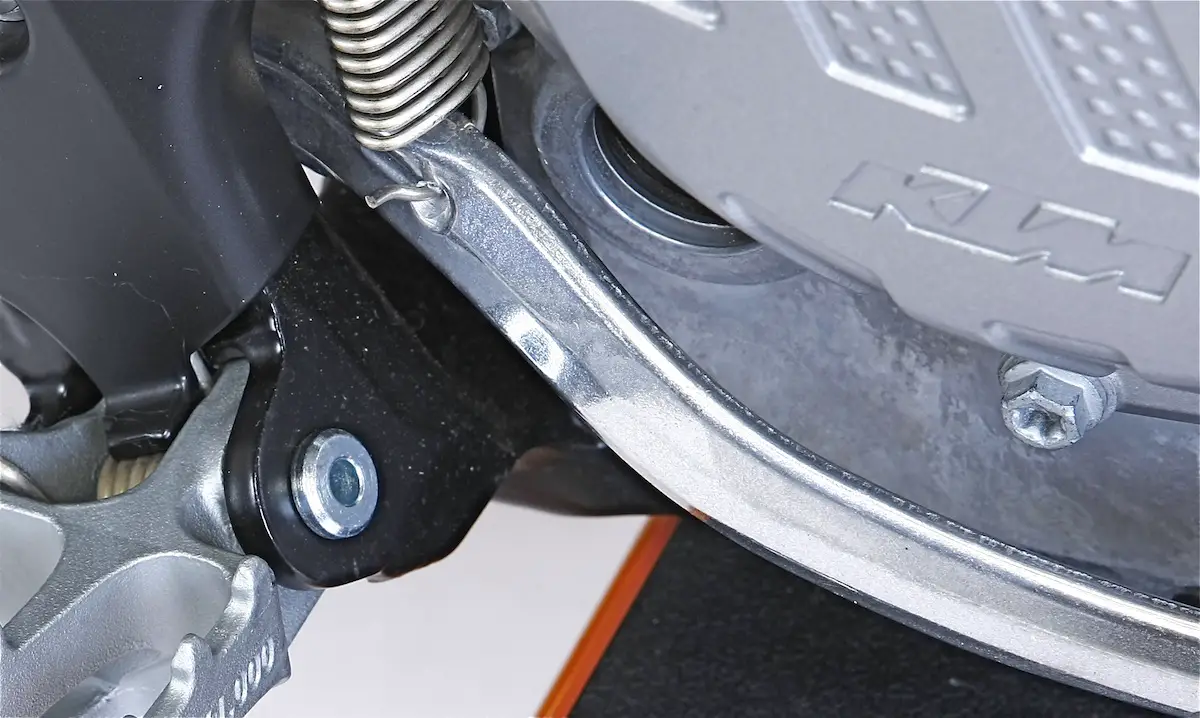 What don’t we like about the shared KTM/Husqvarna brake pedal spring. The tang sticks out of the pedal and can be hit by the rider’s boot—which will knock the brake pedal spring off. We turn the spring around so that the bottom tang faces inward.
What don’t we like about the shared KTM/Husqvarna brake pedal spring. The tang sticks out of the pedal and can be hit by the rider’s boot—which will knock the brake pedal spring off. We turn the spring around so that the bottom tang faces inward.
(6) Brake pedal spring. MXA has broken a lot of Husqvarna brake pedal springs in the past, so we were excited to see the newly upgraded, ovalized rear brake pedal spring. It is more durable; however, it is possible for your boot to hit the tang on the spring and unhook it. We turn the rear brake pedal spring around so that the tang on the bottom of the spring faces inward (and we crimp the tangs to make them hook more thoroughly).
(7) Maps. The 2016 Husqvarna FC450 comes with three different maps. Every MXA test rider ran the aggressive map.
(8) Launch control. Husky’s launch control works like a charm; however, keeping it engaged proved to be a challenge. Once activated, Husky’s launch control will stay engaged until you chop the throttle more than 30 percent (which should be in the first turn). All well and good, except that half the time the MXA test riders accidentally disengaged the launch control system by blipping the throttle before the gate dropped. If launch control disengages, you have to turn the bike off and restart it to reactivate launch control.
(9) Brakes. The Japanese brands have tried to fight back against the Brembo brakes on the KTMs and Huskys with 270mm rotors. And, while these oversize rotors do boost braking power, they are just sticking them onto their left-over master cylinder and caliper piston combinations. Brembo has spent years working out the proper hydraulics to make their front rotor work with their metered pulse — as a result, while the Japanese brakes are better than the were, save for Suzuki, they aren’t as good a Husky’s Brembo unit.
Q: WHAT DO WE REALLY THINK?
A: Husqvarna and KTM hate it when anyone calls a Husqvarna a “white KTM,” but the onus is on the Austrians to delineate what it offers between the orange and white bikes. Until then, KTM will always be considered a donor platform. And, without significant differences, the choice comes down to white or orange. The plastic and graphics are a given, so no Brownie points for those, which leaves the mechanical promises of the plastic subframe, Magura clutch, D.I.D. rims, Pro Taper bars, GFK rotors, new swingarm, gripper seat cover and ice cream cone muffler. These changes add up to a push (some are good and some are bad). We like the Husky, but we’d like it so much more if it was more Husky and less KTM.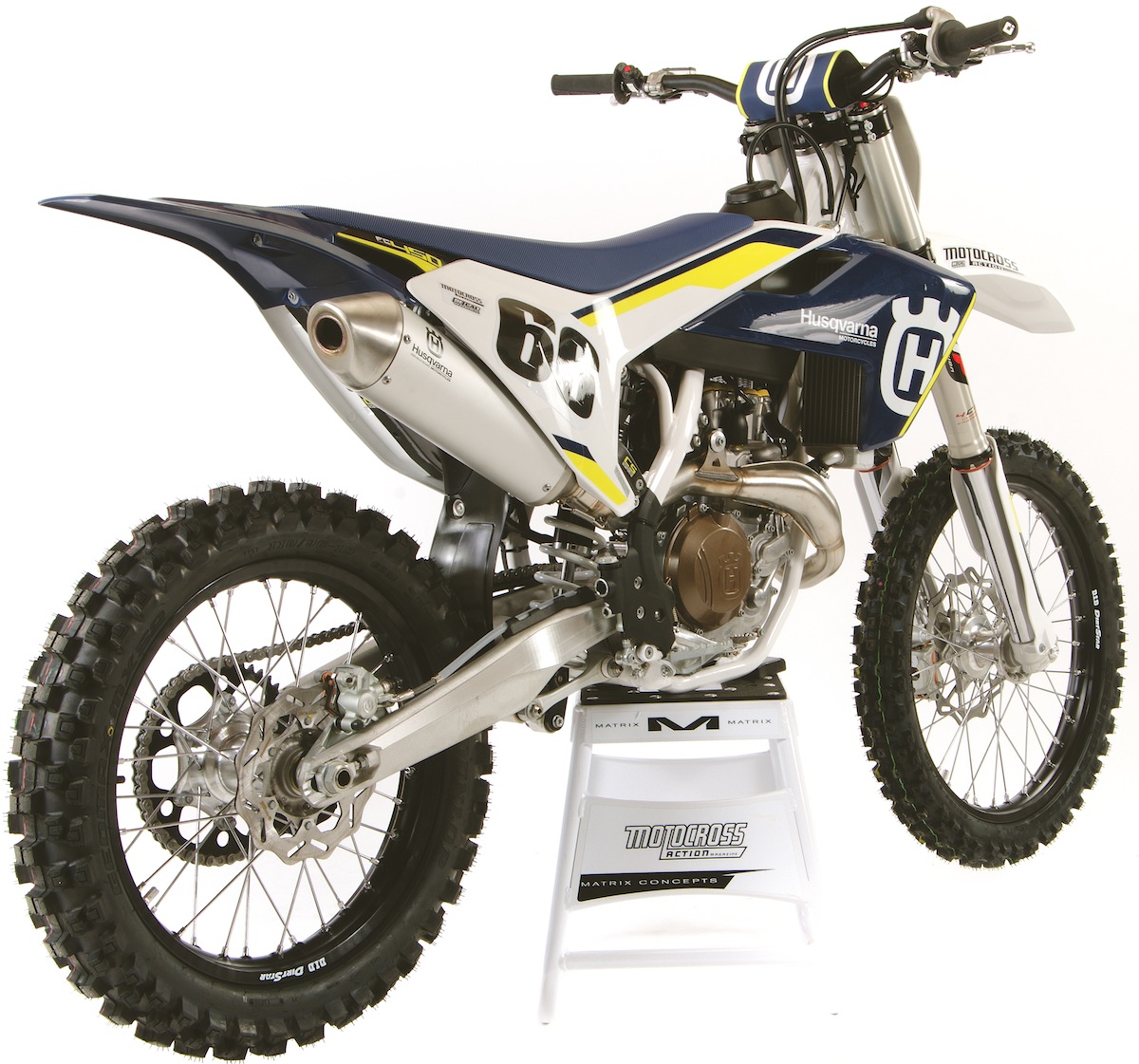
MXA HUSQVARNA FC450 SETUP SPECS
This is how we set up our 2016 FC450 for racing. We offer it as a guide to help you find your own sweet spot.
4CS FORK SETTINGS
It’s not a secret, but if it is, it isn’t very well kept. The 2017 KTMs and Husqvarnas will most likely come with WP AER air forks. No surprise, because the 2016 European KTMs already come with WP’s single-chamber, one-sided air fork. Why aren’t they spec’ed on the 2016 America-bound Huskys and KTMs? Because it was decided that the smaller European market would be the guinea pigs before bringing them to the American, Australian and Canadian markets; however, before you get too upset, the spring-equipped 4CS forks and the Euro air forks share the same basic valving. For hard-core racing, we recommend this fork setup on the 2016 Husqvarna FC450 (stock specs are in parentheses):
Spring rate: 4.8 N/m
Compression: 12 clicks out (15 clicks out)
Rebound: 15 clicks out
Fork leg height: 5mm up
Notes: Faster riders or jump-style tracks might require that 10cc of oil be added to each leg to stiffen the second half of the stroke. Slower rider can turn the compression clicker all the way out — and if that’s not enough, lower the oil height by 10cc.
WP SHOCK SETTINGS
WP recommend 110mm of sag on the 2016 FC450, but ignore that advice. Why? The 48 N/m shock spring has enough trouble getting preload on the spring without having the spring sag set even lower. Plus, the front and rear need to find the perfect balance, and a low-rider rear end will throw the weight bias rearward. For hard-core racing, we recommend this shock setup for the 2016 Husqvarna FC450 (stock specs are in parentheses):
Spring rate: 45 N/m (48 N/m)
Race sag: 105mm
Hi-compression: 1 3/4 turns out (2 turns out)
Lo-compression: 15 clicks out
Rebound: 10 clicks out (15 clicks out)
Notes: If you weigh less than 190 pounds, the stock spring will be an issue. You will need to go softer. When you do, lighten the rebound two clicks and turn the compression in two clicks.
MXA’S 2016 HUSQVARNA FC450 VIDEO



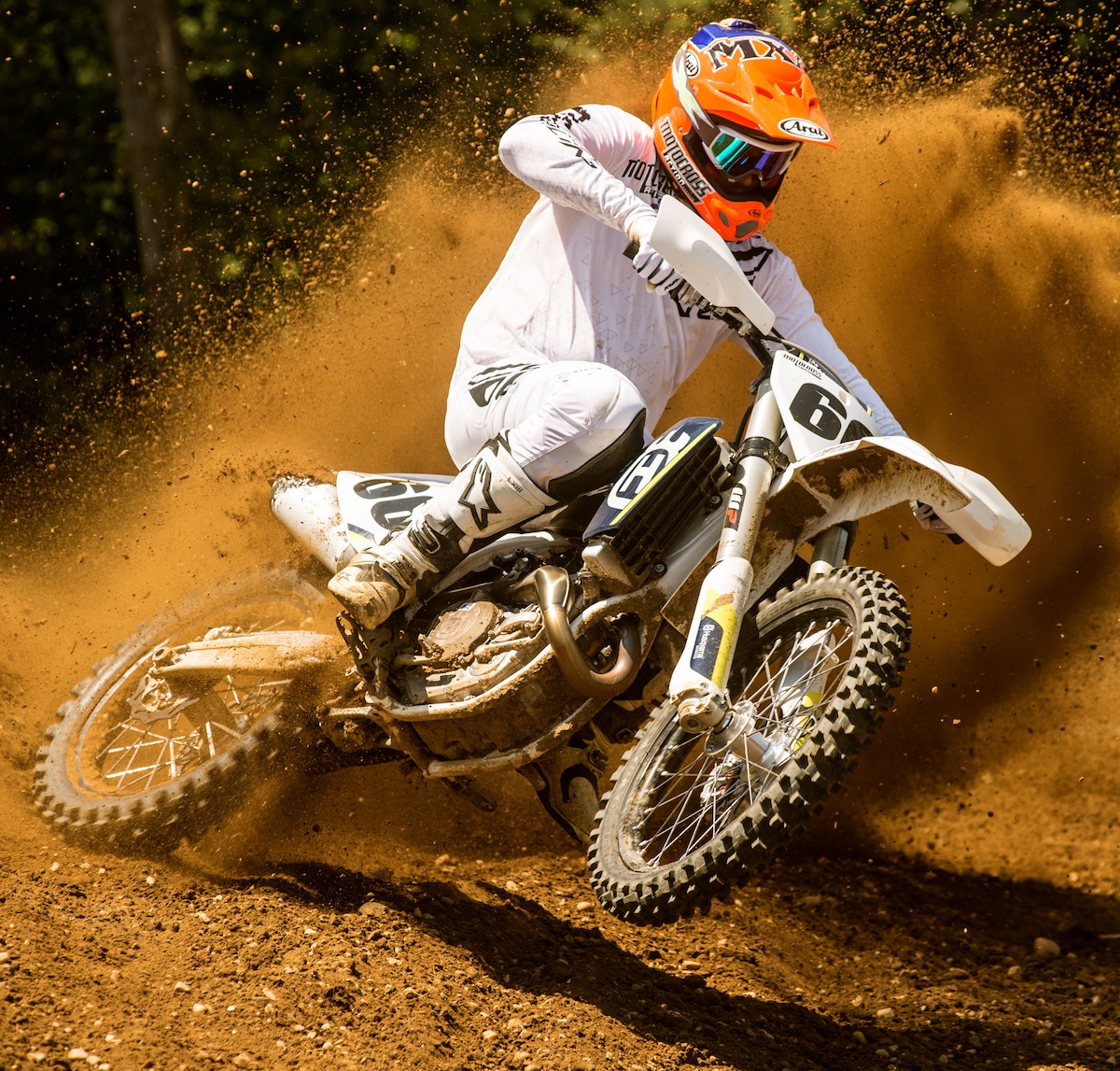
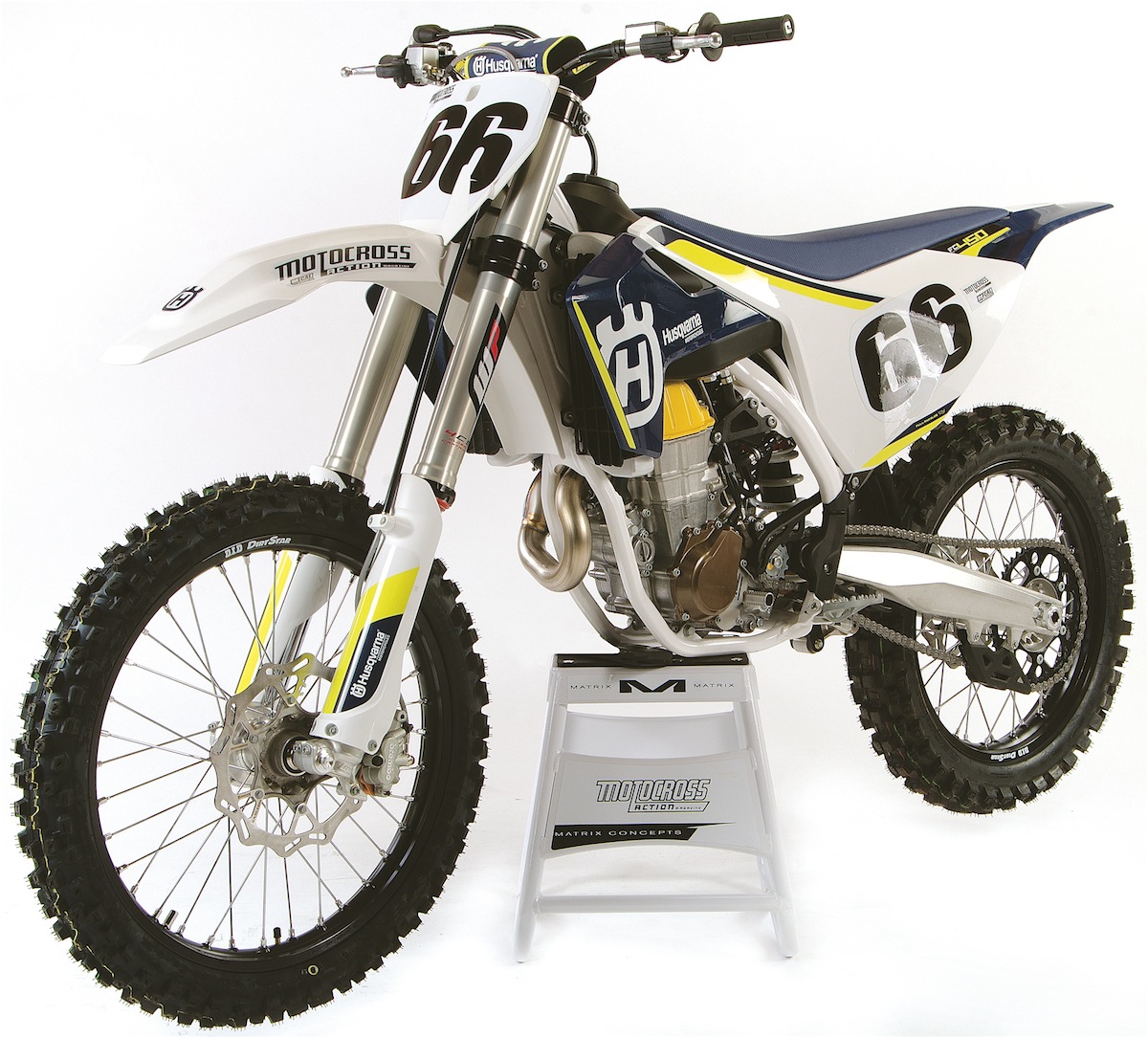
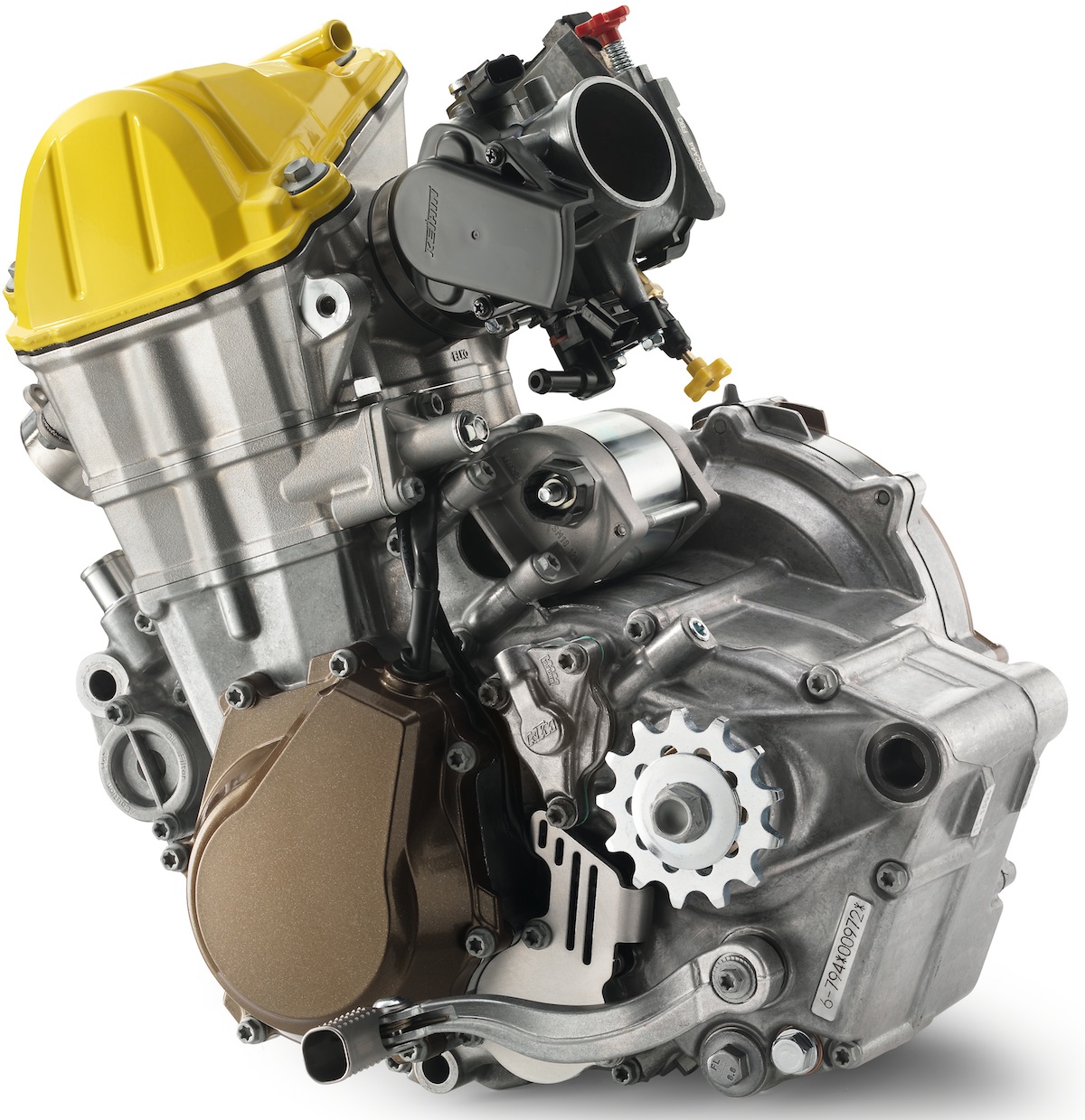
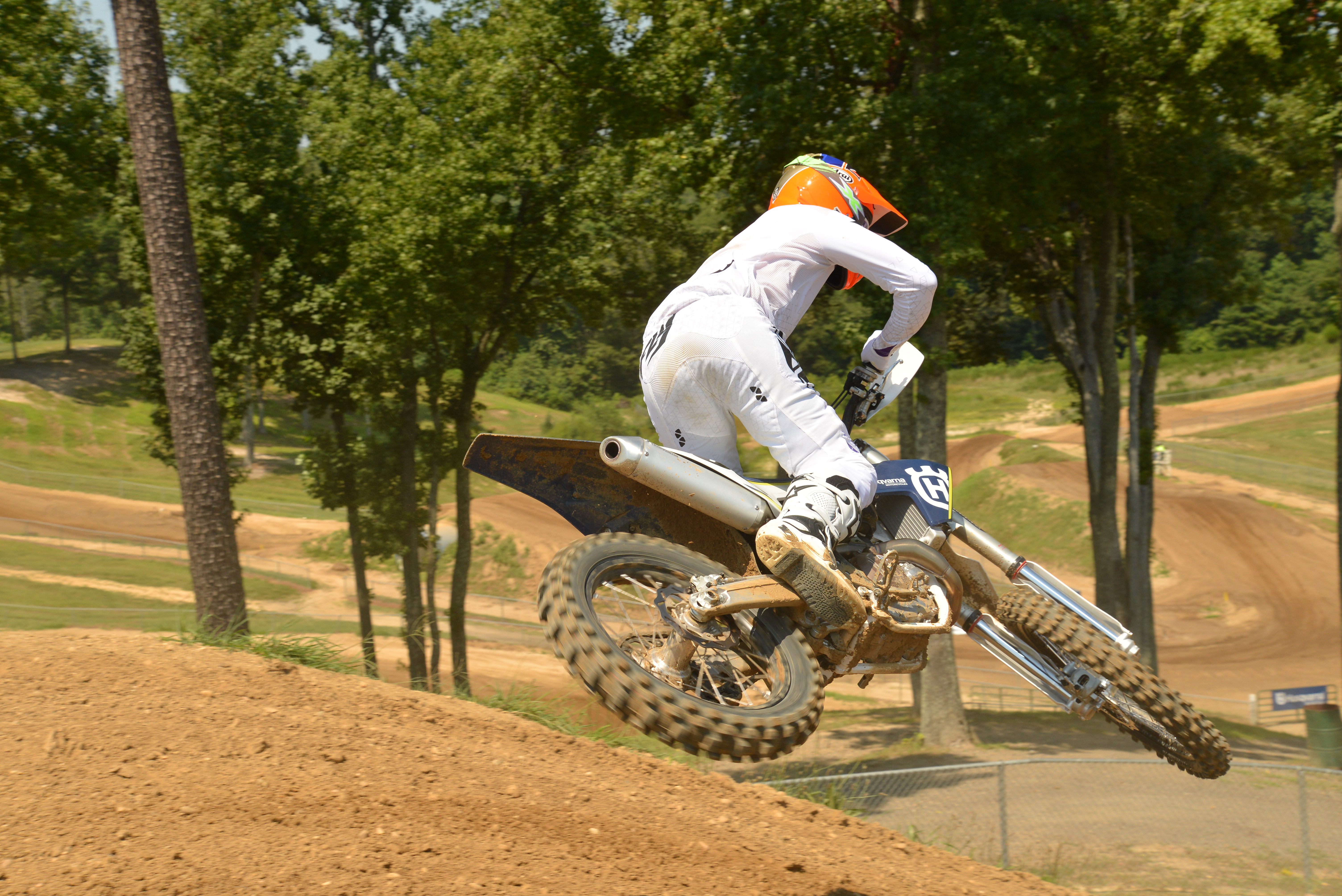




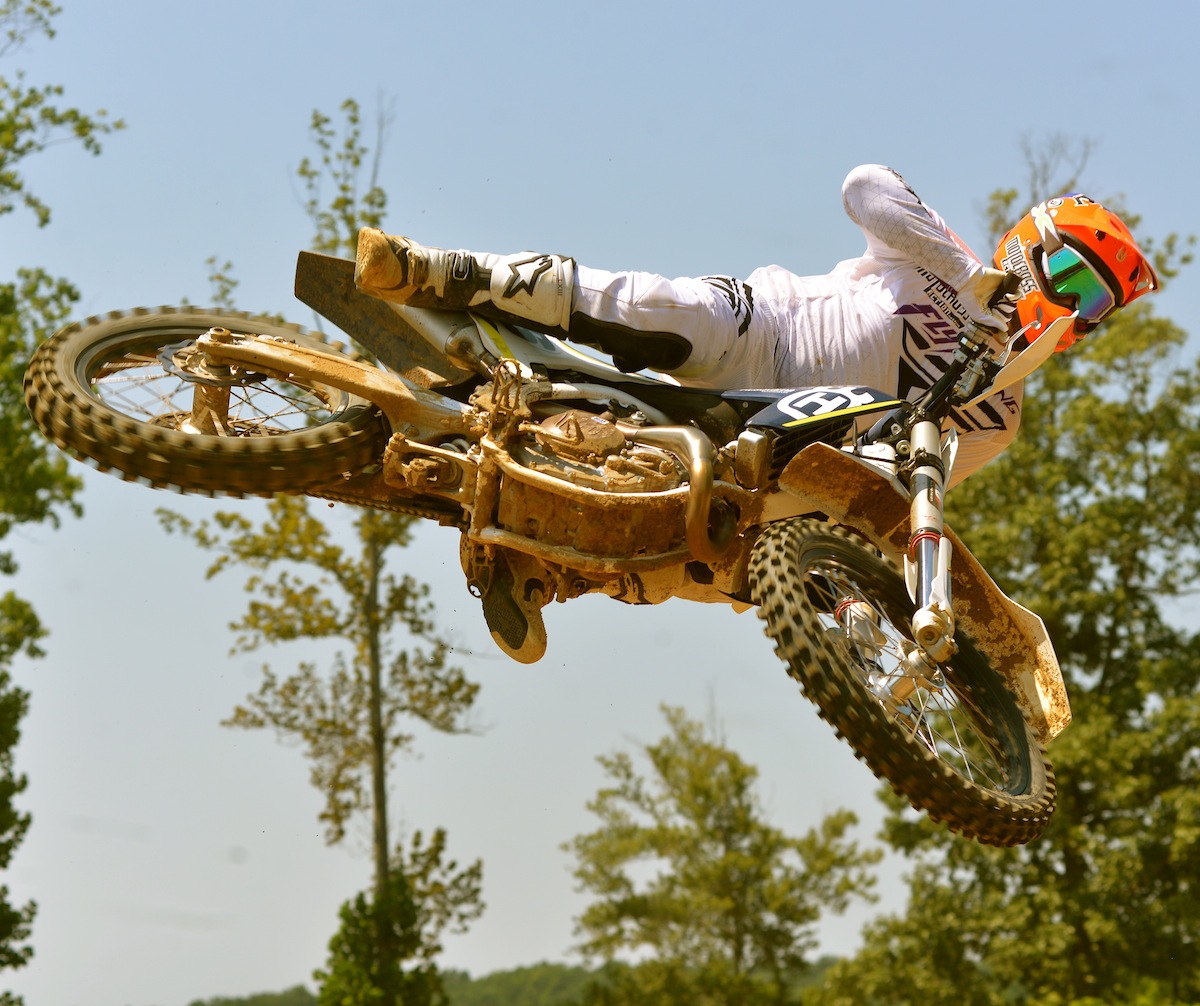
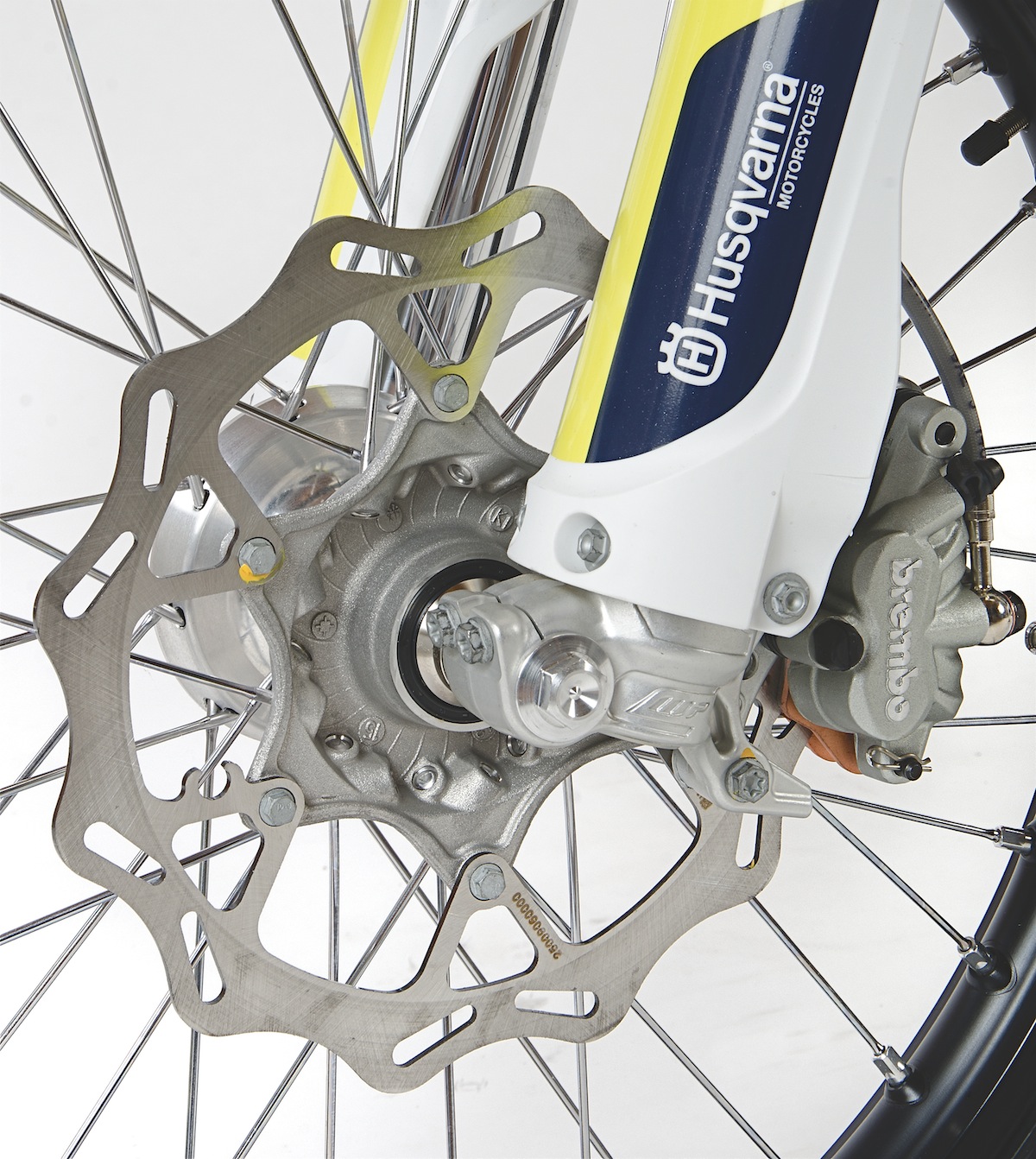
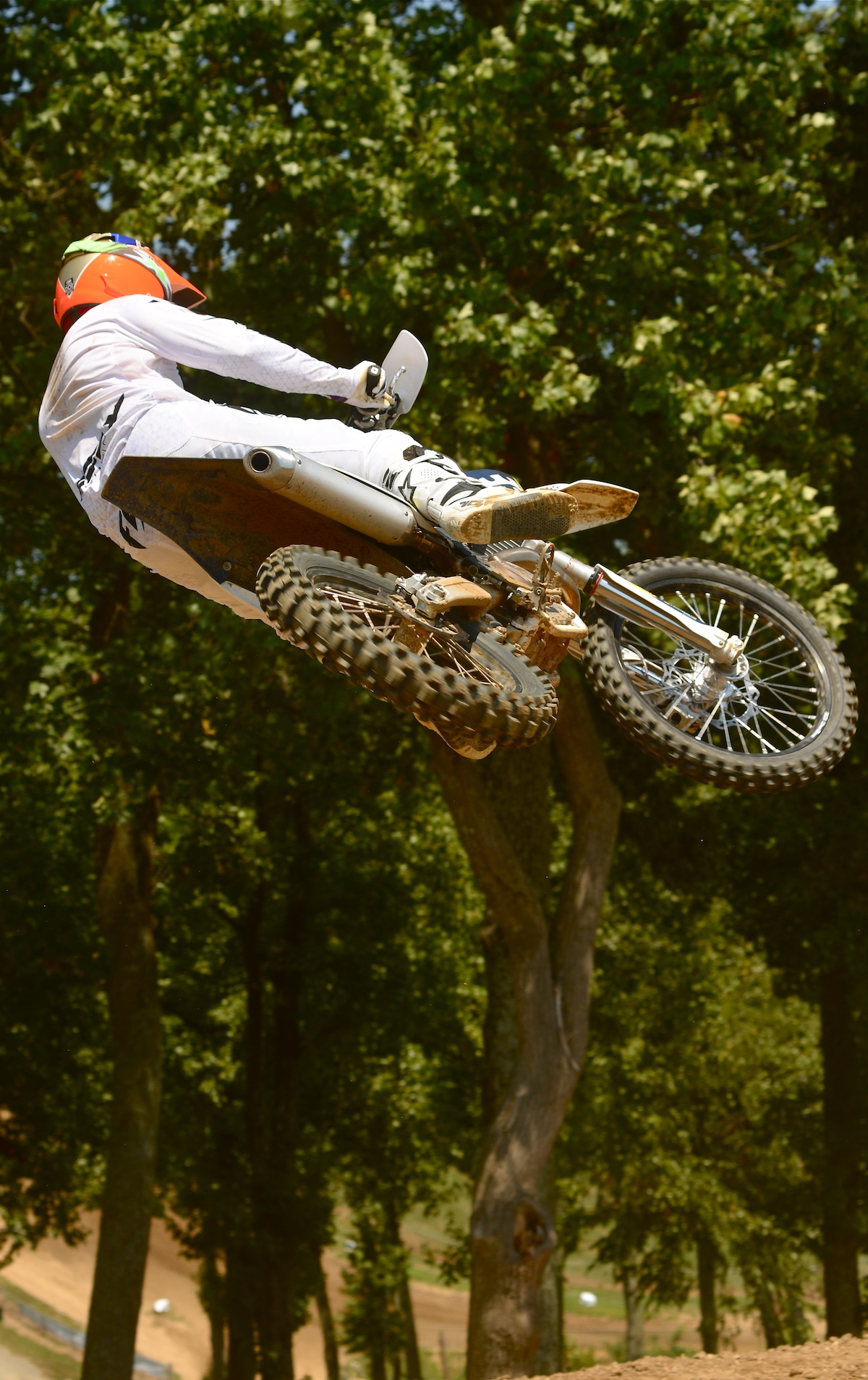



Comments are closed.